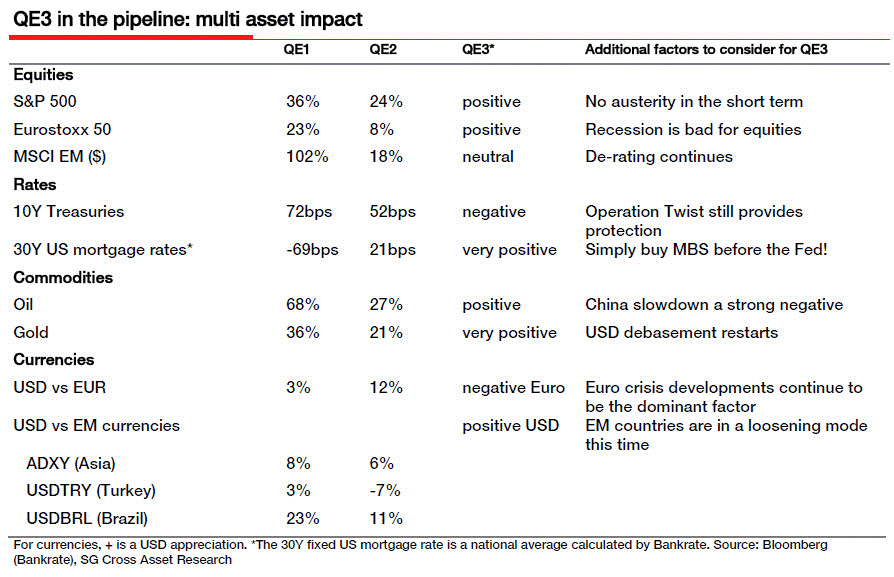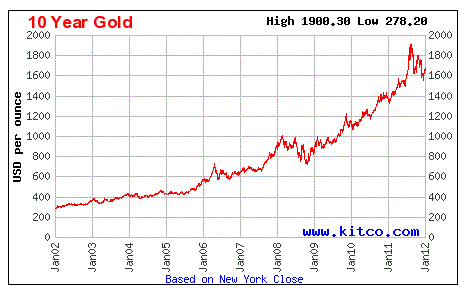It's the beginning of a new year, and there's no shortage of big headlines...
Europe is on the financial brink, Iran is a powder keg, and precious metals like gold have retreated.
It's also a time when there is no shortage of financial forecasts.
Even though these kinds of predictions about the future can be tough to make, I'll admit it's kind of fun to look forward and see what the future may hold.
Like in December 2010, when I said I expected gold to reach $1,900/oz in 2011. Some people thought that I was crazy. At the time, gold was trading for just $1,390/oz.
But just nine months later, that turned out to be a pretty good call as gold hit a new high of $1,923/oz. before eventually pulling back.
Better yet, in January 2010, I even said gold would eventually top $5,000. Of course, most people thought that call was preposterous.
Now, even Standard Chartered bank's analysts expect gold to climb to $5,000.
Gold Price Forecast: Expect Gold to Hit $2200/oz. in 2012
Today, gold price predictions like those are becoming a lot more commonplace. For instance, Goldman Sachs Group Inc. (NYSE: GS) recently set its 2012 gold target at $1,940/oz, while Morgan Stanley (NYSE: MS) now expects gold to hit $2,200.
But what's more important is to actually understand the reasons why market experts believe gold prices will continue to rise.
In fact, to support my earlier $5,000 price forecast for gold, I maintained that one of the underlying reasons was that we would eventually face a currency crisis.
At the time I wrote:
A Currency Crisis is Looming: The "PIGS" - Portugal, Italy, Greece and Spain (or "PIIGS," if you want to include Ireland) - aren't in very good fiscal shape. And they aren't alone. Iceland has already gone over the edge. The United States, the United Kingdom, and countless other economies are struggling. And that reality has ignited a crisis of confidence about fiat currencies in the minds of many investors. Money is nothing more than paper and ink, backed by the full faith and credit of the issuer. When investors find that their faith in the issuer is shaken, the value of that currency erodes. Additional sovereign-debt downgrades from ratings agencies are but one potential trigger of a currency crisis. Under such conditions, gold - the ultimate store of value, and the oldest existing form of money on earth - will soar as investors seek to protect their purchasing power.
That was two years ago...
Today, the recent downgrades of the sovereign debt ratings of France, Italy, Spain, Portugal, Cyprus, Austria, Malta, Slovakia and Slovenia by Standard and Poor's is a confirmation of those very same fears - namely, that Europe's fiscal burdens are not about to lighten.
Inevitably, that has brought about a knock-on downgrade by S&P of the Eurozone's European Financial Stability Facility (EFSF), Europe's own rescue fund.
So now we're dealing with news that the International Monetary Fund (IMF) is looking to boost its bailout fund to a whopping $1 trillion.
And get this...they're reportedly asking emerging markets - China, Brazil, Russia, India, along with oil exporting nations - to bail out the developed world.
Isn't that ironic.
European Black Swan: Potentially a $22 Trillion Problem
For the politicians, Europe is a potential fiscal nuclear device that needs to be disarmed.
According to a recent article by Al Field posted at www.24hgold.com, if just 10% of euro interest rate derivatives produce losses, it could cost the world banking system $22 trillion. That is enough to effectively bankrupt it.
This is one black swan that could well make a crash landing... and soon. You can bet none of this has been lost on the U.S. Federal Reserve either.
That's why there is increasing talk that the Fed will ride to the rescue with its third quantitative easing program, or QE 3 - something I've been saying to expect for quite a while.
And now, a major French bank has joined in on those same predictions. Société Générale SA (PINK: SCGLY) (SocGen) has indicated the Fed is will soon announce QE 3. But it doesn't end there.
They even tell us when this move towards more quantitative easing is likely.
According to SocGen, QE 3 is headed our way this coming March, focused on mortgage backed securities (MBS) purchases on the order of $600 billion over six to eight months. That would be great timing to match up with the pending presidential election. Markets will get a tremendous boost, bolstering support for Obama in the process.
SocGen also tells us what we should buy to profit from this.
They expect the euro and U.S. 10-year Treasuries to take a hit. But they do see U.S. equities, European equities, oil, and especially gold benefiting from this new round of fiat money printing.

I'm in complete agreement on this, especially when it comes to gold.
In fact, just last month, I predicted that gold would reach $2,200/oz in 2012. That's about 33% higher than its current level near $1,650/oz.
Do the fundamentals support it? Well let's check our reasoning.
Is the Fed likely to bring on QE 3? .... Will QE 3 work and for how long?
Is the Fed likely to bring on a QE 4 or a QE 5 in the future?... Where will it all end?
What's more, is Europe likely to default outright, will austerity work, or are more printed money bailouts in store?
Keep in mind, each of these massive money-printing campaigns becomes less effective than the previous ones, so the bailouts tend to grow exponentially.
Of course, in my view defaults would be the right way to go. After all, the lenders who took the risk to lend to insolvent governments would be able to absorb quick losses. The pain would be high, but relatively short.
But I believe there's only a minuscule risk that any government is willing to take the fall for that same solution.
That's why the probabilities of ongoing and ever-increasing bailouts are still very high. And they'll likely continue for some time.
But we aren't helpless. Remember, gold tends to perform well in such an environment. The past decade of annual gains for gold seems to be proof of that.
Take a look at how consistently gold has performed since 2001:

- 2001: +1.96%
- 2002: +24.8%
- 2003: +19.5%
- 2004: +5.35%
- 2005: +18.36%
- 2006: +22.95%
- 2007: +31.34%
- 2008: +5.14%
- 2009: +24.3%
- 2010: +29.8%
- 2011: +14.2%
I know of no other major asset that has turned in this kind of performance...ever. This is what a stealth bull market looks like, one that I fully expect will keep powering on.
And the central banks of the world seem happy to keep feeding it.
In fact, none of the fundamentals supporting gold have gone away. Instead, they've only become even more entrenched.
So if you don't own gold yet, what exactly are you waiting for?
Related Articles and News:


